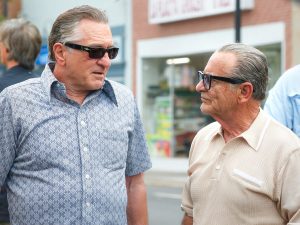Robert DeNiro, Al Pacino, and director Martin Scorsese may be the biggest names attached to “The Irishman,” but the best thing about it is Joe Pesci. He plays Russell Bufalino, a mob boss who speaks in quiet, measured tones that send a true message of power. He never raises his voice, just looks you in the eye until you understand what you must do. It’s a master class in acting and the best performance of his career, very different from his best known roles in “Goodfellas” and “My Cousin Vinny.”
DeNiro is the “The Irishman,” Frank Sheeran, a World War II veteran turned truck driver, who pulls off petty thefts until he is befriended by Bufalino and begins to do his bidding — mostly as a hitman. Russell introduces Frank to his brother, Bill Bufalino, a mob lawyer (Ray Romano), who connects Frank to Jimmy Hoffa (Al Pacino), the all-powerful and quite demanding president of the Teamsters’ Union. On their first phone call, Hoffa tells Sheeran, “I hear you paint houses,” which means splattering walls with the blood and brains of someone you’ve just killed. Sheeran replies, “Yes, sir, and I do my own carpentry, too,” indicating that he cleans up the mess and disposes of the body.
“I Hear You Paint Houses” was the title of Charles Brandt’s book about Sheeran, in which he confessed to many crimes and claimed he was the guy who killed Hoffa, who (officially) disappeared in 1975 and was never heard from again. Writer Steve Zaillian adapted the book for his screenplay, with plenty of input from Scorsese. Thus, “The Irishman” is not based-on-a-true-story as much as it’s based-on-stories-one-guy-told.
Unlike Russell Bufalino’s calm demeanor, Hoffa loved throwing his power around, making speeches, and giving people orders in an always-loud voice. In other words, he’s a character that Pacino knows how to play, with the bluster turned up to full, like so many of his more recent roles. Although he doesn’t appear until 45 minutes into “The Irishman,” Hoffa’s saga fills much of the second half, giving Pacino plenty of opportunities to chew the scenery.
As for Scorsese’s direction, he uses all the tricks he’s mastered over the last five decades of filmmaking, from the shot choices to the music on the soundtrack to the always-perfect editing of his longtime associate, Thelma Schoonmaker. The makeup and aging and de-aging effects are seamless as Sheeran ages from his mid-twenties to early-eighties.
“The Irishman” starts with a long tracking shot, reminiscent of the “Goodfellas” sequence in which Ray Liotta and Lorraine Bracco walked through the back door of the Copacabana, down the hall, in and out of the kitchen, until they were seated in the front row of the showroom. This time, the camera moves down corridors and around corners in a nursing home, past various staff members at work, until it rests on DeNiro’s face in the common room. It’s there that Sheeran begins the narration of the film, just as Henry Hill did in “Goodfellas.”
But Scorsese also uses another framing device that’s unnecessary, a long road trip that Sheeran and Bufalino take with their wives, on the way to a wedding in Detroit. It interrupts the storyline several times, only to force us to watch the women demand that the men stop the car so they can have a cigarette. With the voiceover from DeNiro already in place, the road trip is a needless distraction from an already too-dense plot.
I don’t mind an epic movie that runs more than three hours — if it keeps my interest all the way through. Unfortunately, “The Irishman” is bloated because Scorsese and Zaillian tried to cover too much. For instance, in between Frank’s errands for Bufalino and Hoffa, he drives a truck full of guns and weapons to Miami for use in the Bay Of Pigs invasion of Cuba. He whacks “Crazy” Joe Gallo at Umberto’s Clam House in Manhattan. Then we have to sit through several minutes of characters reacting to and implying that the mob was involved in JFK’s assassination. Perhaps all of that would have been more palatable if, instead of one very long movie, Scorsese had done this project as a four-part limited series for Netflix. That would have changed the pacing and given him the chance to address the various chapters in Sheeran’s adventures separately and offer more opportunities for his outstanding supporting cast, which includes Bobby Cannavale, Harvey Keitel, Stephen Graham, Jesse Plemons, Marin Ireland, Welker White, and Domenick Lombardozzi.
Like many mob movies, there isn’t a single male character in “The Irishman” you’d classify as a good guy. As onscreen titles remind us at regular intervals about some of the minor characters, there was no redemption for any of them, but more often than not a violent end to their lives. The only person who gained my empathy was Sheeran’s daughter Peggy, played as a girl by Lucy Gallina and later as a woman by Anna Paquin. She feels left out, betrayed, and so disgusted by what her father does for a living that she shuts him out of her life completely — thus representing all the women Scorsese hasn’t included in his mob movies other than Karen Hill.
“The Irishman,” which is now streaming on Netflix after a short theatrical run, is a classic example of a movie made by a lot of people I admire and enjoy that somehow didn’t coalesce into the masterpiece I expected. It’s not bad, but it’s not great, either.
I give “The Irishman” a 7.5 out of 10.
Previously on Harris Online…

